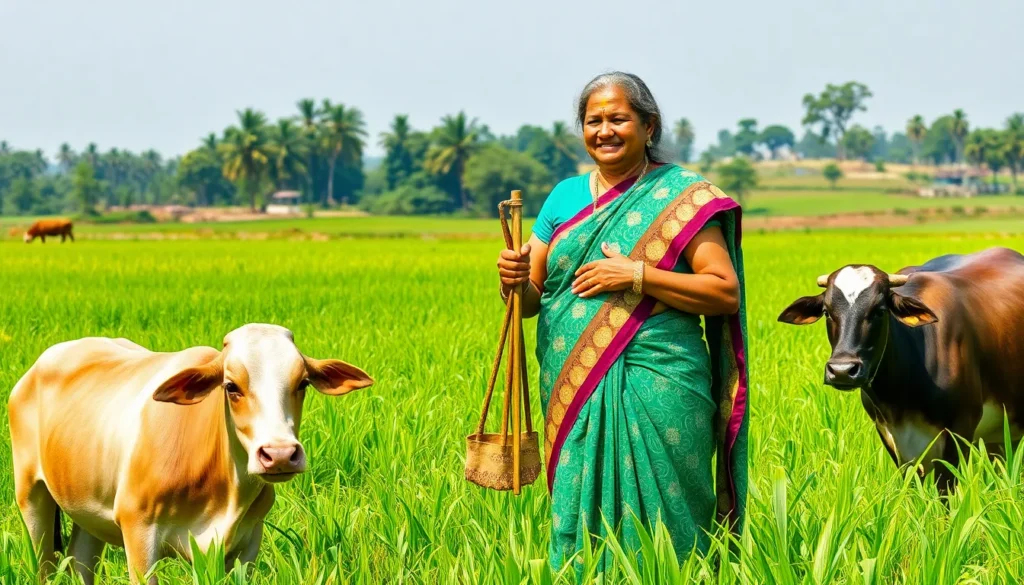Table of Contents
ToggleIn the heart of Indian folklore lies a figure as captivating as she is enigmatic: Gowthalamma. Often celebrated as the protector of cattle and the embodiment of agricultural prosperity, she’s more than just a deity; she’s a symbol of community, tradition, and a little bit of magic. If you’ve ever wondered who’s behind those lush green fields and happy cows, look no further.
Gowthalamma’s legends are steeped in humor and wisdom, making her a beloved figure among farmers and families alike. From her quirky antics to her powerful presence, she’s the kind of goddess who might just show up at your doorstep with a basket of blessings and a cheeky grin. Dive into the world of Gowthalamma, where reverence meets a touch of mischief, and discover why she continues to be a cherished part of rural life.
Overview of Gowthalamma
Gowthalamma holds a revered position in Indian folklore as a protector of cattle. She symbolizes agricultural prosperity and sustains the livelihoods of farmers. This deity is not just symbolic; she embodies community and tradition, intertwining her significance with rural life.
Legends about Gowthalamma vary across regions but often share common themes. One prevalent tale illustrates her playful nature, wherein she saves a village’s crops through clever tricks. Farmers recount how she intervened during challenging times, showcasing both humor and wisdom.
She is celebrated during various festivals, establishing a connection with community members. Rituals involving Gowthalamma include offerings of milk, flowers, and fruits, aimed at invoking her blessings for healthy livestock and bountiful harvests. Families regard these practices as essential in ensuring prosperity.
Gowthalamma’s personality resonates deeply with locals. They consider her approachable, playful, and protective, which fosters a sense of unity among villagers. The tales surrounding her often convey valuable lessons regarding hard work, integrity, and the importance of nature.
Folklore emphasizes her magical presence that transcends ordinary life. In every story shared around the village, Gowthalamma’s character emerges vividly, leaving a lasting impact on both the young and old. Celebrating her legacy strengthens cultural ties and perpetuates the traditions that define rural communities.
Cultural Significance

Gowthalamma plays an essential role in the cultural landscape of rural India. Her influence stretches across various aspects of community life, highlighting values deeply rooted in agricultural practices.
Historical Background
Gowthalamma’s origins trace back centuries, embedding her within the fabric of traditional farming communities. Legends often depict her as a celestial figure who descended to assist farmers during times of need. Significantly, her introduction into agricultural practices marks a historical turning point for enhancing livestock care and crop cultivation. Villagers rely on her teachings to navigate the challenges of farming, thus reinforcing her status as a timeless protector of agricultural prosperity.
Folklore and Legends
Numerous tales surround Gowthalamma, each emphasizing her playful spirit and clever interventions. Stories frequently include her mischievous acts that lead to surprising beneficial outcomes, such as saving crops from adverse weather or disease. Villagers share these anecdotes during gatherings, ensuring her legacy remains alive through generations. Themes of wisdom and humor permeate these narratives, enriching community bonds. Through folklore, valuable life lessons emerge, underscoring the importance of unity and respect for nature among families and communities.
Characteristics of Gowthalamma
Gowthalamma embodies a rich and multifaceted character within Indian folklore. Her unique attributes reflect her revered status in rural life.
Appearance and Attributes
Gowthalamma is often depicted as a robust woman adorned with traditional attire. Brightly colored sarees and elaborate jewelry signify her connection to the earth and agricultural practices. Her gentle face radiates warmth, symbolizing kindness and protection. Farmers frequently describe her as having a serene expression that brings comfort during challenging times. Representations may include her holding tools associated with agriculture, such as a plow or sickle. Cattle often accompany her, reinforcing her role as the protector of livestock. Such imagery fosters a strong connection between Gowthalamma and the agricultural landscape.
Spiritual and Religious Aspects
Spiritual significance surrounds Gowthalamma, making her a central figure in various rituals. Offerings of milk, flowers, and fruits are common during festivals dedicated to her. Villagers participate in ceremonies to seek her blessings for healthy livestock and fruitful harvests. These events strengthen community bonds and deepen connections to agricultural traditions. Prayer and storytelling form vital aspects of honoring Gowthalamma, allowing families to share her legacy across generations. Temples or altars in rural areas often feature her shrine, promoting reverence and gratitude within the community. Her status as a divine protector enhances her role in agricultural practices.
Contemporary Practices
Gowthalamma’s enduring presence is felt through various contemporary practices that celebrate her legacy.
Rituals and Celebrations
Festivals honoring Gowthalamma involve vibrant rituals. Offerings of milk, flowers, and fruits symbolize gratitude for her blessings. During these celebrations, communities gather to perform traditional dances and songs that celebrate agricultural abundance. Specific dates mark these festivities, often coinciding with planting or harvest seasons. Unique regional variations add diversity to the events, each reflecting local customs while honoring the same fundamental themes. Families express their hopes for healthy livestock and bountiful harvests through these gatherings. Rituals serve to fortify community ties and instill respect for agricultural traditions.
Community Engagement
Community involvement plays a crucial role in the practices surrounding Gowthalamma. Local groups organize workshops that share her teachings, focusing on sustainable agricultural techniques and animal care. Engaging in storytelling sessions provides opportunities for the younger generation to learn about her significance. Villagers take pride in organizing clean-up drives near her temples, emphasizing respect for sacred spaces. Various initiatives promote unity and collaboration among community members as they implement her teachings in their farming practices. This collective engagement fosters a deeper connection to cultural heritage and preserves the values rooted in agricultural life.
Gowthalamma stands as a vital figure in the tapestry of Indian folklore and rural life. Her influence extends beyond mere stories; it shapes the values and practices of agricultural communities. Through vibrant celebrations and rituals, she continues to inspire unity and gratitude among villagers.
As traditions evolve, the essence of Gowthalamma’s teachings remains relevant, guiding farmers in their endeavors and fostering respect for nature. The legacy she embodies not only enriches cultural ties but also promotes sustainable practices that benefit future generations. Her enduring presence in the hearts of communities ensures that the spirit of agricultural prosperity thrives, reminding everyone of the importance of connection to the land and each other.




